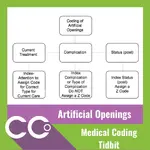Artificial opening status is an important factor that should be coded when present because it affects patient care decisions and requires additional DME resources. Artificial openings may place the patient at risk for infection and may require continual monitoring for patency. It is important for coders to understand what is considered an artificial opening for proper code selection. An artificial opening infers that an opening was made to the outside of the body and is replacing or bypassing a normal body function (eg, colostomy, ileostomy, tracheostomy, etc.). Before selecting a code, make sure the opening is still current because many artificial openings may be temporary (PMH). This is especially true in GI tract-related openings that are moved, shifted, reconnected, etc., as necessary. Nasogastric (NG) tubes, Port-A-Caths, indwelling urinary catheters, and chest tubes are NOT artificial openings. When a patient has a “tube feeding” noted, there may be an artificial opening. The coder can’t know which code to select without documentation of the tube used for the feedings.
Most artificial openings will have two code choices. Coders may select the code for the status of code, which merely documents the opening is current, or coders may select the code for attention to or care for code, which documents that the encounter included care directed to the artificial opening. There may be additional diagnosis codes to choose from if the artificial opening is malfunctioning, to report complications, or if an adjustment or change is made to the opening. The presence of a stoma may be an indicator that there is an artificial opening of some type. The word “stoma” comes from a Greek word meaning mouth. When stomas are created surgically, they have an ending suffix of “-ostomy” and begin with a prefix to identify the organ or area where the stoma was connected.

Most artificial openings will have two code choices. Coders may select the code for the status of code, which merely documents the opening is current, or coders may select the code for attention to or care for code, which documents that the encounter included care directed to the artificial opening. There may be additional diagnosis codes to choose from if the artificial opening is malfunctioning, to report complications, or if an adjustment or change is made to the opening. The presence of a stoma may be an indicator that there is an artificial opening of some type. The word “stoma” comes from a Greek word meaning mouth. When stomas are created surgically, they have an ending suffix of “-ostomy” and begin with a prefix to identify the organ or area where the stoma was connected.



